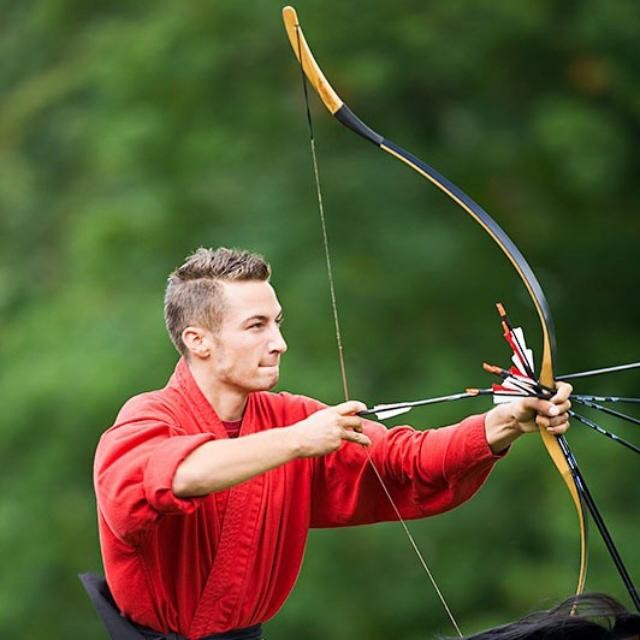
Introduction
Hungarian horse archery was one of the key factors in the victories of the Magyars in battles from the 5th to the 2nd half of the 17th century. The most famous are their 900-970 campaigns. Hungarians, having returned to Pannonia in the beginning of the 10th century, immediately demonstrated their organisational talents not only in their own country but also in relation to others.
And they had ample room: the Pope was threatened by the armed power of secular enemies, the Frankish state collapsed - the kings ascending to the throne, often children, became puppets in the hands of the mighty. The remnants of the Great Moravia were confronted with a German conquest; the countries of East Francia themselves suffered from the Emperor's power. Byzantium and Islam threatened Europe from several directions.
For all these oppressed, the Hungarians proved to be an ideal ally. They defended Great Moravia and the Pope, the kings of France against their rebellious mighty and finally created Austria and Bavaria as buffer zones (Austria until the 12th century was called Regnum Hunnorum in the west). At 100 km a day, they could appear in any endangered place in Europe. In this way they stopped the advance of Byzantium in the southern Apennines and carried out several attacks on Muslims in Spain, Switzerland and Italy.
A key feature of Hungarian units was the extremely effective use of horse archery against enemies of Western Europe, oriental and other nomads. It ensured undisputed victories despite operating in unfavourable terrain conditions (forests, mountains, deserts, densely populated and fortified areas) in the enemy's territory and with a huge disproportion of forces.
Nowadays, this way of warfare evokes associations with the military nature of the Tatars. In Polish historical reconstruction and sport, mounted archery is inspired by the Tatars. Meanwhile, historically, the Polish horse archery and the orientation of the Polish military had been influenced by the neighbourhood of Hungary since the 10th century(!).
Just as the humanitarianism of the Ősmagyars differed from the inhuman behaviour of the Tatars, so the Hungarian type of horse archery was different from that of the Tatars. In some respects, it also dominated over it. Let's compare the key elements of this type of combat in Tatars and Hungarians.
Tartar horse archery
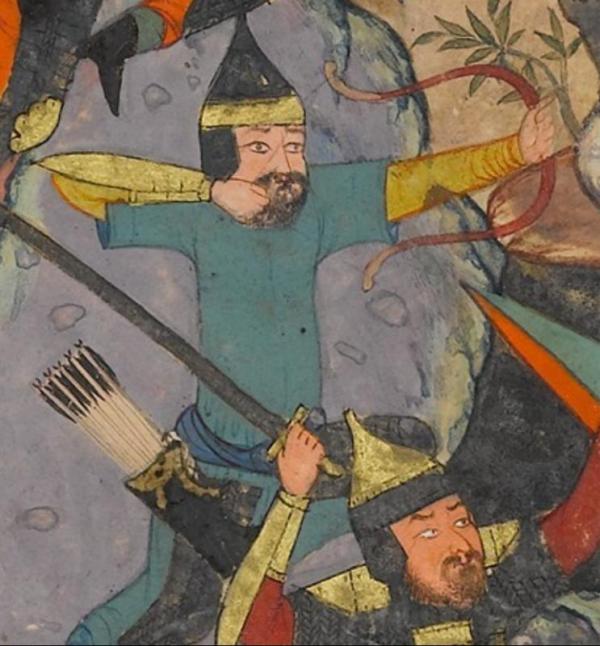
Section of a Tatar miniature from the 15th century. The warrior exhibits Tatar archery characteristics: a short bow, cheek draw with a thumb ring which facilitates rapid shooting
A very short bow was used. If you tried to shoot it with three fingers, it would cause them to be crushed by the bowstring.
For this reason the Tatars pulled the string with a thumb ring – when drawing a bow the arrow would rest on the thumb of the hand holding the bow. This ruled out holding several arrows together with the bow, which is a symbol of Hun - Magyar archery. Contemporary Polish horse archers, modelled upon the Tatars, are only able to do so because they use very thin carbon arrows without historical arrowheads. For shooting with thumb rings, keeping arrows on the bow was discouraged by Persian and Muslim military treaties, Just as today experts in thumb-ring shooting consider it inappropriate, e.g. A. Swoboda in his book The art of using a short reflex bow with an archery ring.
There were also no spare arrows in the draw hand. Because this combination is also possible when drawing with three fingers (then the spare arrows are held by the thumb), I tried to draw like this. It's not easy. Arrows in the draw hand destabilize it. All the more reason it had to be unreliable in the more difficult to master thumb ring draws. Therefore, Polish horse archers do not use it at present either. To shoot quickly pragmatic Tatar warriors relied only on a flat quiver, similar to a machine gun magazine, from which they quickly drew single arrows.
I am recreating a Hungarian- Polovtsian warrior from the 14th century and have recently started to deal with horse archery. After years of three-finger drawing with an arrow on the index finger side of my bow hand during the shot, I am unable to switch to thumb ring drawing, which requires me to run the arrow on the other side of the bow. As it turns out, it is not necessary, because shooting with three fingers on horseback is a thing of the past.
Horse archery, not only in Hungary, but in general, has been recreated by the Hungarian Lajos Kassai Betraying an ignorance of the subject, many thumb ring shooters say that the reason Kassai shoots with three fingers is because he lost his thumb in an accident. However, this sad factor only determines the way in which he anchors an arrow to the bowstring.
Differences in Hungarian and Tatar Horse Archery in the same key elements
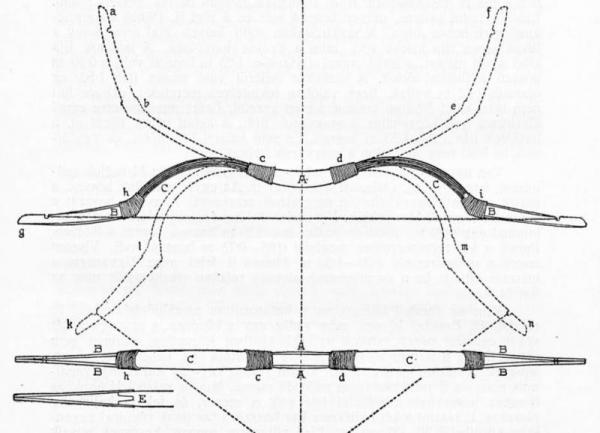
A Hungarian bow
The old Magyar bow was quite long and had long, stiff limb ends - griffins (Hungarian sarvax, horns). It originates from the Hun bow, the size of which (the bow from the Vienna find is almost 2 m!) meant that the lower limb had to be shorter in order to be able to shoot from it whilst mounted. The longer the bow, the more stable it is. Since the Huns, Eurasian nomads, Persians and Byzantines have commonly used bows as long as 1.6-1.8 m in horse archery. The flagship type of bow developed by Kassai - solyóm (falcon) is 160 cm long, and its stability is additionally supported by wide limbs. This bow, different from the Tatar bow was used by Hungarians at least until the 16th century. Such long bows do not crush fingers with the bowstring.

Contemporary Hungarian mounted archers are so skilled with their weapons that they are able to hit shields carried by helper – who are running
Hun and then Hungarian iconography, invariably shows horse archers drawing with two or three fingers. To maintain control of the arrow while riding, the draw hand must be in a diagonal, not vertical, position. Then the index finger presses the arrow against the bow. In a western source written in the 14th century, three-finger drawing by Hungarians is the main difference between the "reflex" Hungarian archery and the Turkish one, which is based on the thumb ring. The finger technique is easier to learn than the thumb ring method..
Since the arrow is guided along the index finger of the bow hand when drawing, it is possible to hold several arrows together with the bow. Other nomads who did not use the thumb ring were also drawing using that method: Scythians, Huns, Bashkirs and Finnish hunters even in the 20th century. This technique allowed the Ősmagyars to dominate over the western and eastern archers. According to an Arabic source from the 10th century, during the time when an archer was putting one arrow on the bow, a nomad (perhaps a Hungarian) fired ten. I have shot so often with different bows and it doesn't make the accuracy any worse or distract attention. I must point out that I use modern arrows with turned arrowheads, which can be pulled out from between the fingers in a flash. Historical arrows with arrowheads had to be chosen from among the fingers, which is also not problematic. As the similarities in iconography from different cultures show, it was also dealt with by holding the arrows on the bow closer to the arrowheads
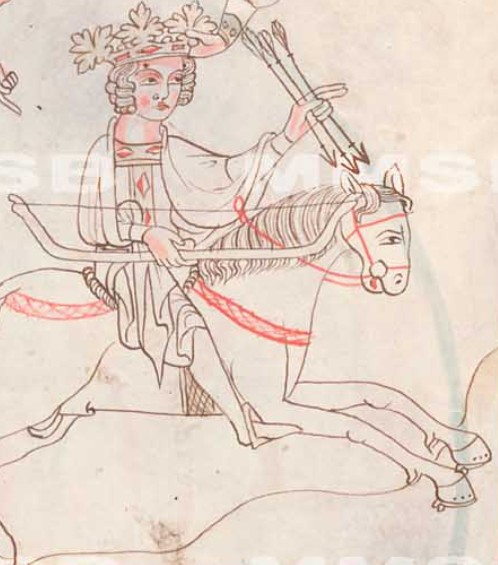
A Rider of the Apocalypse from Velislaus Bible with a bow, similar to a Hungarian bow and holding arrows in the draw hand. Twi digits ready to pull the bowstring
The Hungarian archer was also able to use his draw hand as a "machine gun magazine". The Frankian Utrecht Psalter from the first half of the 9th century shows archers with eastern bows using this technique (and also holding arrows on the bow). Their bows, their use on horseback and the lack of other representations of this technique in the west indicate that it was possible to influence the illustrator of the Psalter (for more on the huge influence of the Huns on the Western European military see my text Huns in Europe, "MW" 7/2018).
As I mentioned before, this is a difficult way to draw, so it occurs less often in iconography. It appears in two 14th-century representations of Hungarian Cumans from the legend of St. Wladyslaw: on frescoes from churches in Nagy Lomnicz and Homoródkarácsonyfalva.
On the first one, Kun draws his bow with two fingers, holding two spare arrows behind the arrow(!) with the other two fingers. They are pointing down at the correct angle, but it is impossible to hold them by arrowhead using bare fingers. In the picture from Homoródkarácsonyfalva, the angle at which the arrows are held is also shown incorrectly. Despite these mistakes, it is certain that the frescoes represent this technique. It can only be used by holding it just below the arrowhead when drawing with a thumb ring or using the original method (pinch).
Hungarian finger shooting is shown correctly in the Czech Welislaus Bible from the second half of the 14th century, in which the Rider of the Apocalypse, who is a horse archer, shoots in the same way. His bow has long, rigid limb ends like the Hungarian one. While studying iconography for the purpose of my recreation I discovered in the 14th century Czech, German and sometimes further inspiration in the Hungarian-Soviet realities for the representation of biblical and fantastic characters.
The Apocalypse Rider, a horse archer at the same time, could only be associated in the Czech Republic with his neighbours, Hungarians or Hungarian Cumans, who in those years often defeated the Czechs and Germans in defence of Poland, using only bows. Also their archery technique, superhuman in the eyes of Western veterans, had to evoke certain emotions. In no other depiction does the Rider of Apocalypse, an archer, hold a bow like this. It is therefore possible to assume the influence of the Magyar on the Bible illustrator, by which the said Rider uses the Hungarian shooting technique, holding the spare arrows vertically with his thumb in the middle of the shaft. It coincides with the depictions of the Utrecht Psalter. In the same manner a supply of arrows was also held in the draw hand in ancient Egypt, Assyria, Eskimos, and Africa.
My attempts to shoot in this way show that even though it has a destabilizing effect on the draw arm, it is quite easy to achieve the same rate of fire. I probably wouldn't have had a problem with accuracy if I'd shot like this for a long time. This technique, as a problematic one, remained rare and today also no-one bothers with it. Even the unparalleled Hungarian archers.
What else did Hungarian archery stand out for?
Anchorage point. Today, most archers in the historical reconstruction anchor the arrow at mouth height. The Hungarian iconography often shows an anchor point in the neck area, but like many others, it often omits or distorts a number of elements. The Illustrated Chronicle, for example, is credible in terms of costumes, but the archers shown in it are without quivers.
These Hungarian representations, which are distinguished by their credibility, consistently show the drawing of an arrow right under the eye or at its height, as in most English archers' representations. Probably it also originates from the Danish tradition - Procopius of Caesarea wrote that in his time the archers abandoned the low drawing of the arrow in favour of the eye level anchoring copied from the Bulgars. I myself use the anchorages that are considered the most precise in Eastern archery. By contrast, Tatar iconography, accurate and of a high artistic value, from the 13th to the 16th century always shows a draw at the level of the corner of the mouth.
"Japanese" drawing technique. A. Dürer's painting depicting the personification of death shows it shooting from a bow raised above its head in a starting position, as in Japanese archery. This method of drawing is such a specialized task that its presentation by the artist excludes making it out of ignorance, imagination or for the purposes of composition. His representations from Europe come from the whole Middle Ages with iconography from Poland (especially from the south), Finland, Russia, occasionally from the West and Byzantium. Also in these last two cultural regions, horse archers are shooting in this way in the illustrations. So probably Hungarians used it right from the outset.
On the basis of my own experience (on foot only) I can say that the "Japanese" technique ensured high accuracy when shooting with a bow with a high draw length for the archer. Unlike Japanese archery, where this technique is used mainly in ceremonial shooting, Hungarian warriors and hunters benefited from it in real combat. Therefore, when I started shooting with this technique, I did not consult with the archers training Japanese ceremonial archery, confining myself to conclusions from iconography.
The first step is to raise the bow above the head in an outstretched hand. The second is lowering it, combined with pushing it towards the target and drawing of an arrow. The last two operations must be carried out at the same level and at the same speed. Once anchored, a drawn bow remains in place for the duration of the aiming, pushing the bow hand and pulling the bowstring all the time.
After some time I abandoned this technique, but it is now very popular among users of traditional bows. It is also used by A. Swoboda and recommended in his book.
Hungarian horse archery did not disappear in the 10th - 11th centuries. In the 12th century the Hungarian tournaments, apart from jousting, included archery and, only for princes, crossbow competitions. As the anonymous author of the Gesta Hungarorum chronicle emphasizes, archery tournaments were an element of the old, local tradition, and not borrowed from somewhere else. Similarly, in Bulgaria the traditional archery competition survived until the 1920s (!!!!) and it was not the only remnant of the Huns in the Bulgarian folk culture at that time. In general, as A. Biró wrote in his article Dating (with) weapon burials and the 'Waffenwechsel'. Preliminary report on Viking-age swords in the Carpathian Basin lacked evidence of a general rejection by Hungarians of traditional military art in the 10th century and adoption of western ways. This is also evidenced by the continuity between the early medieval Avar and ősmagyar sabres and the late medieval Hungarian sabres - but this is a subject for a separate article.
The quiver

The author’s quiver, made by Sebastian Świst
The type of quiver (tubular) has not changed in Hungary from the Hun era until the first half of the 16th century, despite the proximity of the Golden Horde and Turkey, where a flat quiver, now associated with 17th century Poland, has been used since the beginning of the 14th century.
When recreating the Hungarian-Cuman horse archer, I also took into account all the realities shaping the material culture of Hungarians and Cumans using the same type of quiver.
The first one was the choice of raw material. Tubular quivers, used from the 6th to the 16th century from China to Western Europe, were made from birch bark, leather or wood. The first two were used on treeless steppes. Wood was used in western and northern Europe, where it was easier to get, and where leather was harder to come by. Such situations had to occur often during the consistently permanent settlement of the Hun and then Avar, Hungarian Cuman settlement on the territory of today's Austria, Switzerland or in those regions of Hungary which were devoid of steppes.
This is confirmed by a finding from Altdorf, dating back to the 7th century in which a western archer was buried with quiver made out of lime-tree. It was copied from the Huns or Avars or captured on them. Because my character also made use of local craftsmanship, I decided to go for a lime quiver. In 15th century Poland, this type of quiver was made of wood and it was forbidden to cover it with expensive leather.
This type of quiver is found in Władysław Jagiełło's 1418 horse portrait from Lublin. Here one can undoubtedly take into account the Hungarian influence, and not the Tatar-Russian influence (as I mentioned above, for Tatars the tubular quiver was replaced by a flat no later than in the beginning of the 14th century). This is also indicated by its presence in iconography from western Poland, the Czech Republic and Germany.
Linen was glued to the interior of mine according to the Cuman quiver found in the Caucasus. During my horse trials it turned out that the arrows could not be placed with the arrowheads upwards, as the iconography always shows, because during the ride they would fall out.
In addition, if the individual arrows so arranged are selected, turning them to the correct position would delay the shooting, which is unacceptable when riding fast. If they are inserted with the fletching pointing up, you can draw more arrows very quickly.
The wooden material of the quiver turned out to be a good choice for the Hungarian archer in one more matter. The 14th-century report says that Hungarian commanders signalled manoeuvres, rattling with quivers - they heard their own, but not their enemies. From my experience I know that a wooden quiver (which works like a resonance box) is much better suited for this than a leather or bark quiver. Thanks to such signals and manoeuvres, Hungarian horse archery, identical to that of the 10th century, was still effective. In 1286 the German knights were defeated by the horse archers themselves in a battle described by von Steier in the Rhymed Chronicle.
Here I will turn to another factor affecting the efficiency of Hungarian horse archers. The Tatars, both during the great conquests of Genghis and Timur and the Crimean Tatars in the 17th century, fought against large armies. Contrary to popular belief, heavy cavalry and other types of troops played a major role. Small units, armed mainly with bows, if they acted independently, were only capable of robbery, reconnaissance or diversion.
Meanwhile, the Hungarians could often send from several hundred to several thousand warriors on key expeditions to change the course of wars during the Hungarian invasions of Europe. Nevertheless, their effectiveness was undisputed. They also used heavy cavalry, but scant horse archers turned out to be the main offensive force. It also resulted from perfect training in manoeuvres, marches and cooperation of units with each other and with an ally. There were scouts circling around the walking light cavalry, signalling with horns. Depending on the situation, warriors could assume a chosen formation at lightning speed. Like other nomads, they were able to quickly create wagon fort, the invention of which is wrongly attributed to the Hussites. The army of the pre-Teutonic Prussians and Yotvingians had similar abilities, in whose culture there are also clear nomadic elements.
Equestrianism
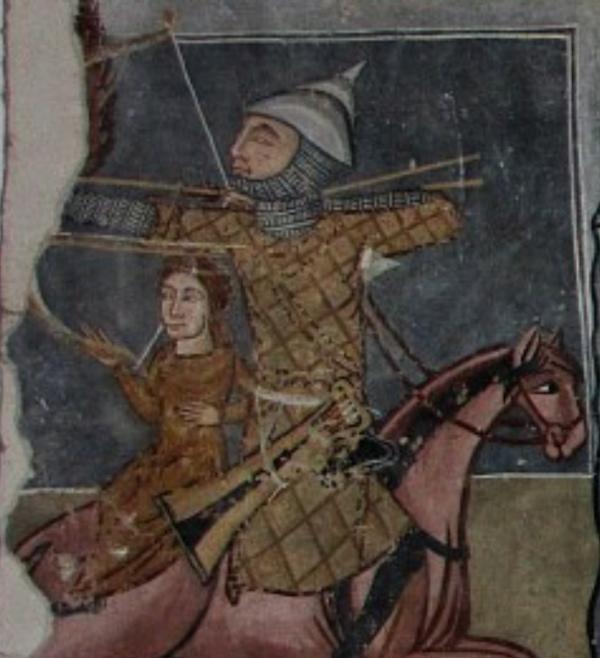
A Cuman depicted on a fresco at a church in Homoródkarácsonyfalva
Victories were won by the fast movements of the nomadic army. Like the Tatars, the Hungarians travelled 100 km a day, not for robbery, but to surprise the enemy army. For example, in 1161 the last Piast expedition to Kiev took place. Poles and Hungarians, go in an expedition in defence of the rights of Mstislav Isiaslavich, who is threatened by Yuri Dolgoruki. And he, as the name suggests, had long hands - intrigues. In the immensity of the Russian steppes an emissary reaches the warriors, saying that the Prussians have attacked Mazowsze, perhaps inspired by Dolgoruki. Thanks to the speed of action, as in 900-970, the Hungarians and Poles thwarted the Prussians and set off for Kiev, beating Yuri, surprised by such a turn of events. Mstislav became a great prince.
Fast marches, mounted shooting and sword fighting were the result of Attila's excellent mastery of the equestrian art. The decisive factor here is the fact that children ride a horse before they learn to walk and talk, as well as a different position than in Western Europe or in Arabian horse riding, where for this reason horse archery was ruled out. In the Middle East, since antiquity, horse archers have been shooting from a still position and the Turks quickly adopted it, giving up the nomadic army. Therefore, when they attacked Hungary in the 14th century, they had no equals for horse archers.
In horseback combat, the victory of both duels and entire troops is determined by the superiority of riding, not armament. For example, in the 10th century, when close combat took place, the Magyars were able to stop the crossing of blades in an instant and relocate, going into gallop and then canter from standstill. Still in 1848, when a Habsburg cavalryman with a firearm was standing in front of a Hungarian armed with a whip, he was not able to hit him and the insurgent took his weapon with a whip.
The situation was similar in pre-Teutonic Prussia and in Poland before the introduction of the rising trot. Until the 19th century, Poles aroused admiration in western observers, because they rode horses differently, did not trot, but galloped from standstill. Not to mention how the morale of the western enemy was affected by the sight of Polish riders attacking ion canter...
Today, Hungarian, and not Australian or Dutch mounted archers, for example, are world champions, which proves how successive generations have passed on this skill of their ancestors to the next generation. This sport is associated by the Hungarians with the values of the old warriors. Respect for private property and other Hungarian values today define the Magyars as they did for Attila, Koppanya and Rakoczi.
Contemporary Hungarian masters of horse archery are the promoters of their own history and its transmission according to the Magyar proverb: you have to take fire from the past and leave ashes in the past.
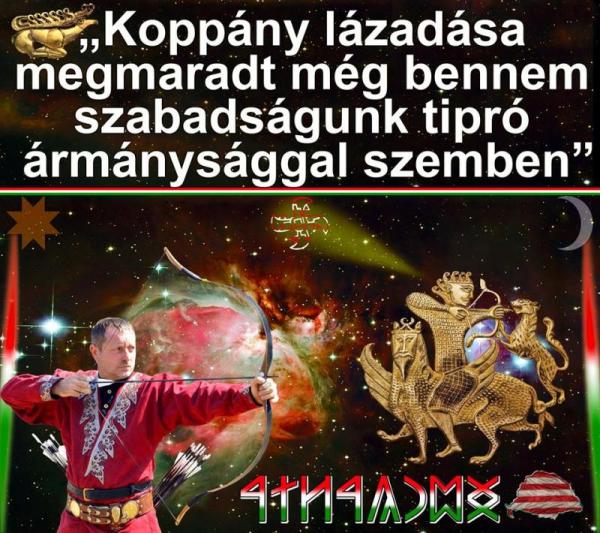
A contemporary Hungarian image with a reference to mounted archery traditions
Meanwhile, in Poland the past is often perceived as harmful: through the prism of nostalgia or oblivion, and Polish historical archery is wrongly perceived as a result of foreign influences. Modern Polish horse archers, despite being at the forefront of the world, do not spread patriotism like the Hungarian ones - neither do they flaunt it by themselves and they are not burdened with the same expectations from Poles. And few people know that strong ties between Poles, Hungarians and Croats result from the fact that they came from one Scythian-Sarmatian origin.
Jakub Juszyński
Autor jest z wykształcenia historykiem, zajmuje się historią Węgier, Połowców węgierskich, Polski Piastowskiej i Prus. Publikuje w „Mówią Wieki”, „Pruthenii” i „De Re Militari”, opublikował też w „Nowej Fantastyce” opowiadanie „Z latopisów Białej Ziemi”. Para się rekonstrukcją historyczną Węgier i działa w Stowarzyszeniu Jeździeckim „Szarża”.
